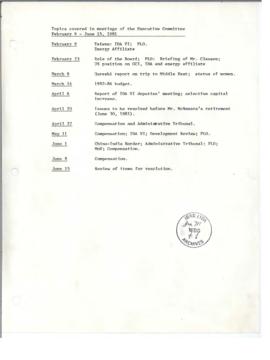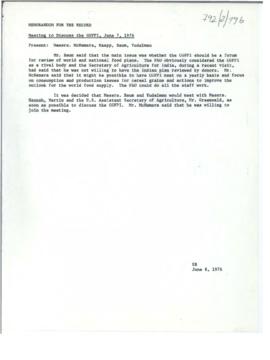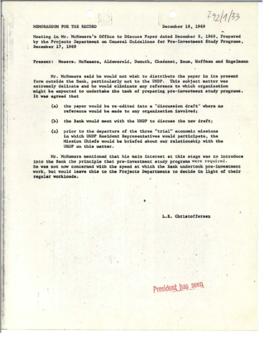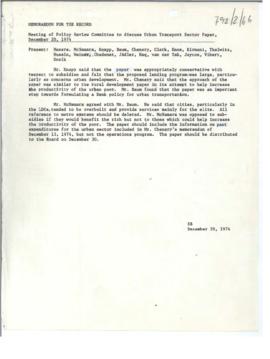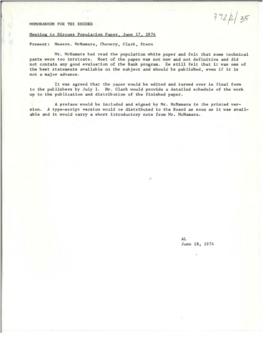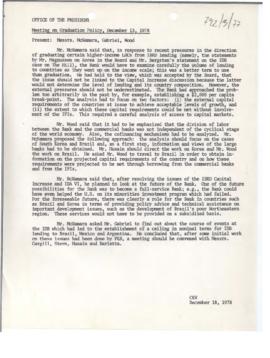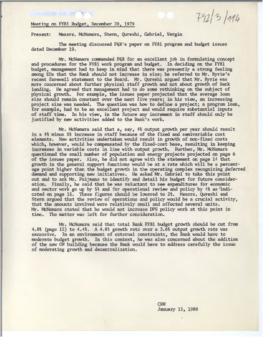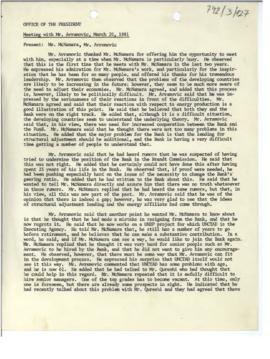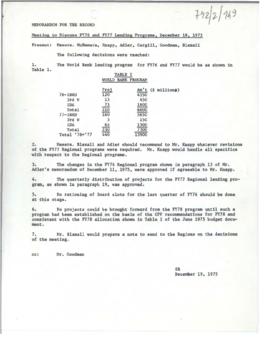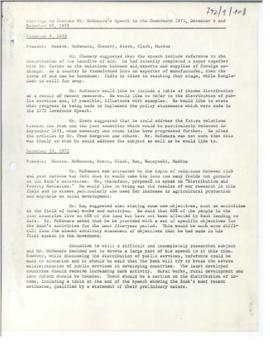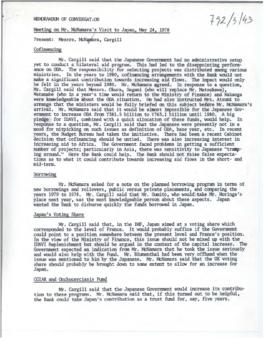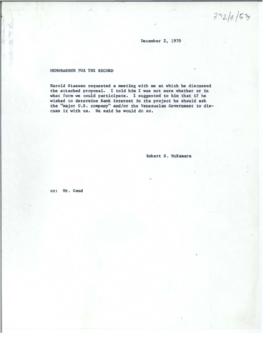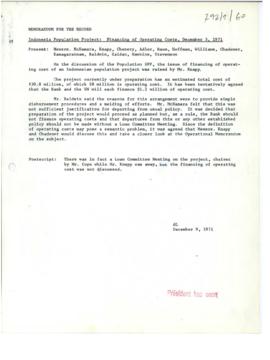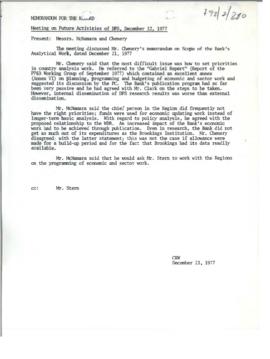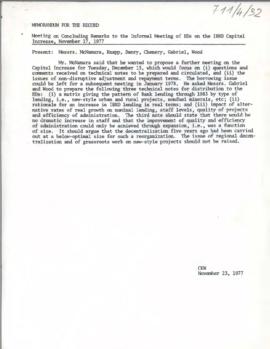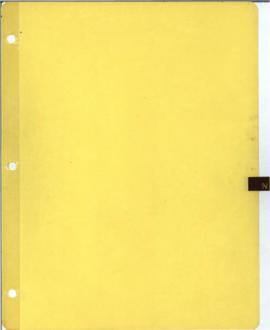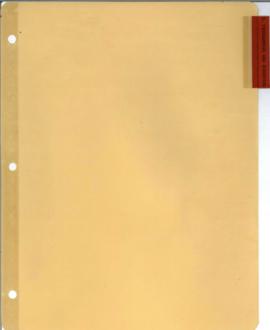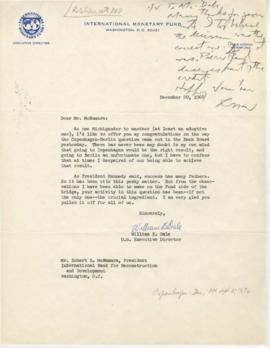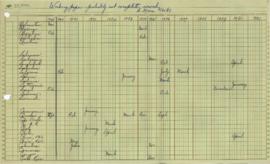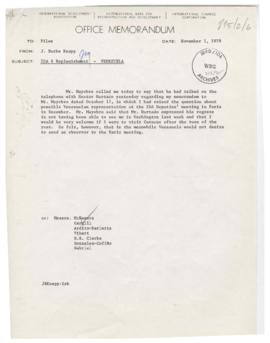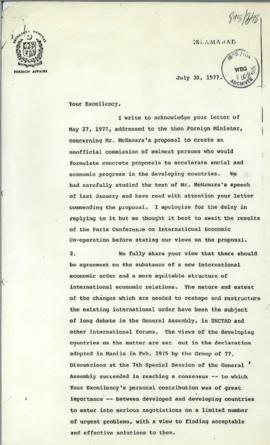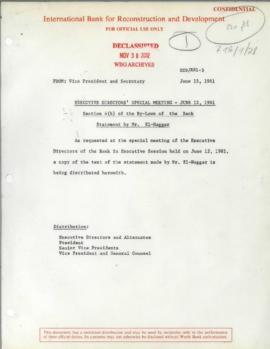Identificatie
referentie code
Titel
Datum(s)
- 1968 - 1981 (Vervaardig)
Beschrijvingsniveau
Deelarchief
Omvang en medium
42.30 linear feet of textual records; 95 photographs
Context
Naam van de archiefvormer
Biografie
Robert Strange McNamara (1916-2009) became President of the World Bank Group in April 1968. This followed seven years as United States Secretary of Defense and a period at the Ford Motor Company in the 1950s where he ascended to the position of president. Over the course of his thirteen years as President of the World Bank, McNamara brought considerable change to all aspects of Bank operations. The Bank began to specifically address problems of income disparity and poverty and diversified into sectors previously ignored by both the Bank and the burgeoning development community. It also began to play a more active and at times critical role in many developing economies.
The most prominent action McNamara took upon first becoming World Bank Group President was to dramatically increase the volume of lending. Based on his first five-year lending plan, he proposed to the Governors of the World Bank Group at the Annual Meetings in 1968 that the Bank double the volume of lending during the next five years. His second five-year plan, introduced in 1973, proposed another 40% increase. Bank commitments rose from $1 billion in 1968 to $13 billion in 1981. In order to prepare projects at the necessary rate, McNamara introduced the Country Program Paper (CPP) in 1969; the purpose of the CPP was to provide an overall and long-term development strategy for each country.
The number of staff increased by 125% during McNamara's first five years, and from 1,600 to 5,700 over the course of his tenure. Diversification in the nationality of staff also increased. In order to accommodate the expanding volume of business and the corresponding increase in staff, McNamara undertook a massive, Bank-wide reorganization in 1972. The most significant aspect of the reorganization was the integration of the former Projects Division, which consisted of sector specialists responsible for operational project work, into one of five new Regional Vice Presidencies (RVP). Thus, rather than one Projects Department supporting projects in countrieson an ad hoc basis, each RVP would maintain its own projects staff. As a result, staff responsible for both sector skills and country knowledge would necessarily work more closely together.
In order to mobilize the resources to fund this massive expansion of Bank operations, McNamara found less conventional avenues of support. He looked beyond Wall Street to Germany, Japan, and the Middle East. He also increased borrowing from central banks and broke into the European pension trust market. In 1969, he hired Eugene Rotberg to take command of these ambitious borrowing plans.
McNamara focused on the issue of population growth more than any other Bank President. The Bank's first financing for family planning was approved under McNamara in 1970. He also continued to expand the Bank's emphasis on agricultural lending. With the support of the Bank's economic research lead, Hollis Chenery, McNamara recommended measures such as land and tenancy reform and programs to increase the productivity of small farmers. Education lending also grew during McNamara's tenure, increasing threefold between 1968 and 1981. In the middle to late 1970s, urban poverty was increasingly identified for renewed focus by the Bank; urban assistance programs aimed at increasing employment opportunities, improving squatter settlement programs, supporting small-scale enterprise financing, and implementing plans for basic services in transport, electricity, water supply, and education.
McNamara also made a concerted effort to increase the financial support and status of development finance research in the Bank. This was evidenced by the Bank's early sponsorship of the Consultative Group on International Agricultural Research (CGIAR) and by the recruitment of the distinguished development economist, Hollis Chenery, to run the Bank's research activity and to be its chief economist. Chenery was encouraged to undertake general research as well as to provide analytical guidance to the new operational and sector policy units. By the time of McNamara's departure from the Bank in 1981, it was able to claim a role as an intellectual leader in development matters.
Towards the end of his time as President, the World Bank Group became even more involved in the economic policies of borrower nations through the proliferation of structural adjustment program lending. This included a call for a reorientation of economic policies to accomplish higher savings and investment rates, greater efficiency in the domestic use of capital, and more emphasis on the private sector than previously advocated. Structural adjustment loans provided financing that would induce reforms but would also deliver significant negotiable resources.
In terms of the organizational structure of the Bank during McNamara's tenure, the most significant change was the previously described 1972 reorganization. The arrangement of McNamara's most immediate advisers was not considerably altered. He maintained the formal structure of the President's Council as put in place by his predecessor GeorgeWoods, although the responsibilities of its members were distributed on a more functionally specific basis: as Senior Vice President of Operations (SVPOP) , Burke Knapp was responsible for lending and technical assistance activities only; Simon Aldewereld was designated Vice President of Finance (VPF); Mohammad Shoaib was named Vice President, Organization Planning and Personnel Management (VPO) and became responsible for administrative matters; and Vice President Dennis Rickett, who came on board with McNamara, was assigned responsibility for liaison with Part I countries and IDA replenishment negotiations.
Following the retirement of Vice Presidents Alderwereld and Rickett in 1974 and, earlier, Development Services Director Richard Demuth, a number of changes were instituted, many of which involved the RVPs. Significantly, the Director, External Relations (DER), who had supervised the Information and Public Affairs Department (IPA) and all functions previously assigned to the Development Services Department, was upgraded to a Vice President, External Relations. William Clark was named EXTVP. In 1978 the Vice President, Finance was upgraded to Senior Vice President, Finance (SVPFI), reflecting added responsibilities. I.P.M. Cargill, who had replaced Simon Aldewereld upon his retirement in 1974, was named SVP. Cargill was, in turn, replaced by Moeen Qureshi in 1980.
After more than thirteen years, McNamara departed the Bank in June 1981. Several of his most prominent managers and advisers left with him upon his departure, including: William Clark, his public affairs chief; Mahbub ul Haq, his most visible and articulate progressive; and Hollis Chenery.
archiefbewaarplaats
Geschiedenis van het archief
Directe bron van verwerving of overbrenging
The history of the McNamara Presidential records is complicated. Some series were transferred to the Archives from the Office of the President. Other series contain records that President McNamara took with him when his tenure at the Bank was completed, later transferred to the Joint Bank-Fund Library where Blanche Moore, his former secretary, worked, and still later were transferred from the Library to the Archives. Finally, some series were transferred to the Archives from other parts of the Bank, particularly from offices where the President's former staff members worked after leaving the President's office. The source of each series or, in certain cases, file units is described in the archival description for that series.
The records are incomplete. President McNamara retained certain items when he transferred the bulk of the records in his custody to the Joint Library. He declined to turn over what Ms.Moore described as Tapes Bank-related, and he instructed her to remove the dictated impressions of the trips from his file on contacts with member countries (WB IBRD/IDA 03-04-05 Contacts - Member Countries files). Ms. Moore laterwrote that the items she removed from the Contacts file were personal notes written by Mr. McNamara for his own reference and were not distributed to staff members; thus, they are not official records of the World Bank and Mr. McNamara has retained them.
Inhoud en structuur
Bereik en inhoud
Robert S. McNamara became World Bank President on April 1, 1968 and served 2 full five year terms and a partial term, leaving on June 30, 1981. The records are a very full account of his long and active presidency. Every part of the world is reflected in these records, as well as virtually every economic issue of the 1970s. Any student of the Bank during the McNamara years will find reading these records an essential first step for research.
When McNamara came to the World Bank, it was lending about $1 billion per year. When he left in 1981, Bank lending stood at about $12 billion a year. In addition to the dramatic increase in volume of loans, he refocused Bank lending beyond infrastructure and projects to basic human needs and poverty reduction. Using the term absolute poverty, his annual meeting speech in Nairobi in 1973 marked a turning point by identifying promoting rural development and alleviating the conditions of life to the poor as crucial development goals. He identified population growth as a major issue for the Bank to address and the Bank began proving support for family planning programs. The Bank also began providing loans for pollution control.
McNamara proposed the formation of the Consultative Group for International Agricultural Research (CGIAR), which makes major contributions to increasing global food production and reducing hunger. He mobilized Bank resources to launch an international onchocercieasis (river blindness) control program. He initiated two international commissions to examine world development: the Pearson Commission in 1968 and the Brandt Commission in 1977. The Joint Ministerial Committee of the Board of Governors of the World Bank and the International Monetary Fund on the Transfer of Real Resources to Developing Countries, usually known as the Development Committee, was established in 1974 to support international cooperation in development activities and coordination of international efforts in finance development, and to provide advice to the Board of Governors of the Bank and the Fund on all aspects of the transfer of real resources to developing countries. And in 1978 the World Development Report was launched, the Bank's flagship publication on development issues.
Records of all these activities can be found in the records of the McNamara presidency. An unusually large number of records are annotated by McNamara, providing unparalleled insight into the thinking and decision-making processes of the president.
The records also include files form assistants to the President, notably two series from economic adviser Irving S. Friedman that include his correspondence with both President George Woods and President McNamara.
Waardering, vernietiging en slectie
Aanvullingen
Accruals are not expected.
Ordeningstelsel
Voorwaarden voor toegang en gebruik
Voorwaarden voor raadpleging
Records are subject to the World Bank Policy on Access to Information.
Voorwaarden voor reproductie
Records are subject to the Copyright Policy of the World Bank Group.
Taal van het materiaal
- Engels
Schrift van het materiaal
Taal en schrift aantekeningen
Fysieke eigenschappen en technische eisen
Toegangen
Two types of finding aids are available. For all series, an Inventory List is available that provides a list of the file units belonging to each series. In addition, when some of the records were in the custody of the Joint Library, Blanche Moore made extensive lists, often at an item level, and filed them at the beginning of the series or at the beginning of a file. These finding aids were accessioned with the records when they were transferred to the Archives from the Joint Library and form part of the series. They are also described in the series descriptions.
Verwante materialen
Bestaan en verblifplaats van originelen
Bestaan en verblijfplaats van kopieën
Related units of description
Aantekeningen
Alternative identifier(s)
Trefwoorden
Onderwerp trefwoord
Geografische trefwoorden
Naam ontsluitingsterm
Genre access points
Beschrijvingsbeheer
Identificatie van de beschrijving
Identificatiecode van de instelling
Toegepaste regels en/of conventies
Internal World Bank Group Archives rules based on ISAD(G).
Disclosure status
Niveau van detaillering
Verwijdering van datering archiefvorming
21 July 2006


